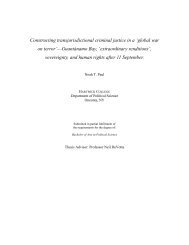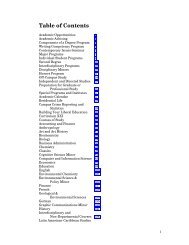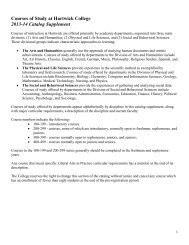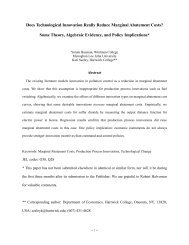Endocrine Disruptors in Amphibians: Analysis of ... - Hartwick College
Endocrine Disruptors in Amphibians: Analysis of ... - Hartwick College
Endocrine Disruptors in Amphibians: Analysis of ... - Hartwick College
Create successful ePaper yourself
Turn your PDF publications into a flip-book with our unique Google optimized e-Paper software.
<strong>Endocr<strong>in</strong>e</strong> <strong>Disruptors</strong> <strong>in</strong> <strong>Amphibians</strong>: <strong>Analysis</strong> <strong>of</strong> the Effect <strong>of</strong><br />
Two Common Environmental Pollutants<br />
Clarence P. Owens<br />
Department <strong>of</strong> Biology<br />
<strong>Hartwick</strong> <strong>College</strong>, Oneonta, NY 13280<br />
2005<br />
This thesis is submitted <strong>in</strong> partial satisfaction <strong>of</strong> the requirements for the degree <strong>of</strong><br />
Bachelor <strong>of</strong> Arts from the department <strong>of</strong> Biology, <strong>Hartwick</strong> <strong>College</strong>.<br />
Thesis Advisor<br />
Date<br />
Chair, Biology Department<br />
Date
<strong>Endocr<strong>in</strong>e</strong> <strong>Disruptors</strong> <strong>in</strong> <strong>Amphibians</strong>: <strong>Analysis</strong> <strong>of</strong> the Effect <strong>of</strong> Two Common<br />
Environmental Pollutants<br />
Clarence Owens<br />
Dr. Stanley K. Sessions, Thesis Advisor<br />
ABSTRACT<br />
This study exam<strong>in</strong>ed the effects <strong>of</strong> common environmental pollutants <strong>in</strong> amphibians (frogs <strong>of</strong> the<br />
genus Rana) and mammals (laboratory mouse, Mus musculus). The effects <strong>of</strong> the pesticide atraz<strong>in</strong>e and the<br />
gasol<strong>in</strong>e additive MTBE on growth, development, and sex differentiation were studied <strong>in</strong> frogs, and the<br />
effects on the immune system were exam<strong>in</strong>e <strong>in</strong> mice. Experimental methods <strong>in</strong>cluded morphology,<br />
hematology, histology, and hemolytic plaque assays. Frogs were treated from the time <strong>of</strong> hatch<strong>in</strong>g to<br />
metamorphosis. Growth was determ<strong>in</strong>ed by weight, and development was determ<strong>in</strong>ed as percent reach<strong>in</strong>g<br />
metamorphosis after a given amount <strong>of</strong> time. Sex differentiation was studied first by morphological<br />
exam<strong>in</strong>ation <strong>of</strong> the gonads <strong>in</strong> newly metamorphosed frogs, and was then confirmed histologically. The<br />
mice were treated for three weeks, beg<strong>in</strong>n<strong>in</strong>g at 16 weeks <strong>of</strong> age and the effect on their immune system was<br />
exam<strong>in</strong>ed us<strong>in</strong>g the hemolytic plaque assay (HPA) to measure the number <strong>of</strong> activated (antibodyproduc<strong>in</strong>g)<br />
B-lymphocytes. Results show that atraz<strong>in</strong>e has a large but negative impact on growth and<br />
development, but no discernable effect on sex differentiation <strong>in</strong> frogs. MTBE (methyl-tertiary-butyl-ether),<br />
a gasol<strong>in</strong>e additive, has little or no effect on growth and development <strong>in</strong> frogs, but appears to have a<br />
pronounced effect on sex differentiation. The effects <strong>of</strong> contam<strong>in</strong>ants on the immune system <strong>in</strong> mice are<br />
equivocal, but other, unexpected detrimental effects were observed. These results suggest that atraz<strong>in</strong>e and<br />
MTBE are both environmental tox<strong>in</strong>s and may act as endocr<strong>in</strong>e disruptors with variable effects on<br />
amphibians and mammals. These chemical contam<strong>in</strong>ants may therefore be play<strong>in</strong>g a role <strong>in</strong> amphibian<br />
decl<strong>in</strong>es and could also pose hazards for human health.<br />
INTRODUCTION<br />
<strong>Amphibians</strong> are considered to be good “<strong>in</strong>dicator” organisms with which to study<br />
the biological impact <strong>of</strong> environmental chemical pollution because they depend on water<br />
or moisture to reproduce and to breathe through their th<strong>in</strong>, highly vascularized sk<strong>in</strong>.<br />
Recent reports <strong>of</strong> widespread decl<strong>in</strong>es, disease, and deformities <strong>in</strong> natural populations <strong>of</strong><br />
amphibians have raised concerns that environmental contam<strong>in</strong>ants may be to blame,<br />
especially those than can act as endocr<strong>in</strong>e disruptors. There is ample evidence that<br />
gonadal differentiation <strong>in</strong> amphibian species is highly sensitive to sexual hormones.<br />
Estrogens can <strong>in</strong>duce a sex reversal <strong>in</strong> genetic males, where either an ovotestis is produce<br />
or complete and permanent fem<strong>in</strong>ization occurs (L<strong>of</strong>ts 1974). Kloas et al. (1999) reported<br />
that bisphenol A and 4-nonylphenol significantly altered the sex ratio <strong>in</strong> Xenopus laevis.<br />
Dibutyl phthalate and styrene <strong>in</strong>duced gonadal fem<strong>in</strong>ization <strong>in</strong> Rana rugosa (Ohtani et al,<br />
200, 2001). Recently, hermaphroditic gonads <strong>in</strong>duced by Atraz<strong>in</strong>e <strong>in</strong> X. laevis were<br />
reported by Hayes et al. (2002). Legitimate concerns have been raised not only about the<br />
disappearance and deteriorat<strong>in</strong>g health <strong>of</strong> natural populations <strong>of</strong> amphibians, but also<br />
about the broader implications for human health and well be<strong>in</strong>g.<br />
The endocr<strong>in</strong>e system operates through a complex series <strong>of</strong> events triggered by<br />
chemical messengers that choreograph development and function. Chemical messengers
are <strong>in</strong>volved <strong>in</strong> sexual differentiations. Cell division leads to the construction <strong>of</strong> tissues<br />
and organs that eventually determ<strong>in</strong>e future function, such as sperm production and<br />
ovulation. <strong>Endocr<strong>in</strong>e</strong> disruptors work by a variety <strong>of</strong> mechanism. First, they can<br />
impersonate natural hormones by b<strong>in</strong>d<strong>in</strong>g to receptors and <strong>in</strong>itiat<strong>in</strong>g a new cellular<br />
response. Second, an endocr<strong>in</strong>e disrupt<strong>in</strong>g chemical may b<strong>in</strong>d and block the receptor,<br />
thereby mak<strong>in</strong>g the regulatory switches unavailable to signal the body’s naturally<br />
produced hormone messengers. Third, concentrations <strong>of</strong> the natural hormone can also be<br />
affected when man made chemicals promote or <strong>in</strong>terfere with the breakdown <strong>of</strong> the<br />
hormone by the liver enzymes system. Fourth, dur<strong>in</strong>g development, endocr<strong>in</strong>e disrupt<strong>in</strong>g<br />
chemicals can altar the number <strong>of</strong> receptors <strong>in</strong> develop<strong>in</strong>g tissue types, thereby<br />
predispos<strong>in</strong>g these tissues to abnormal responses later <strong>in</strong> life. The changes <strong>in</strong> expression<br />
can lead to functional deficits changes <strong>in</strong> how an organism’s immune, reproductive, and<br />
other systems perform (Smolen et al. 1997).<br />
The two chemicals that were tested <strong>in</strong> this experiment were Atraz<strong>in</strong>e and MTBE.<br />
Atraz<strong>in</strong>e (2-chloro-4-ethylam<strong>in</strong>o-6-isopropylam<strong>in</strong>e-1,3,5-triaz<strong>in</strong>e): the most commonly<br />
used herbicide <strong>in</strong> the United States and is currently used <strong>in</strong> more than 80 other countries.<br />
MTBE (methyl-tertiary-butyl-ether): a commonly used gasol<strong>in</strong>e additive that <strong>in</strong>creases<br />
the efficiency <strong>of</strong> combustion, thereby reduc<strong>in</strong>g particulate emissions.<br />
The purpose <strong>of</strong> this experiment was to determ<strong>in</strong>e whether Atraz<strong>in</strong>e and MTBE act<br />
as endocr<strong>in</strong>e disruptors. I will <strong>in</strong>vestigated the effects <strong>of</strong> widespread environmental<br />
contam<strong>in</strong>ants on natural populations <strong>of</strong> amphibians us<strong>in</strong>g an assay for immune function<br />
that to our knowledge has not been used with frogs before, but which we have found,<br />
from our pilot studies, to be a relatively fast, simple, and effective way to quantify<br />
activated B-cell (antibody-produc<strong>in</strong>g lymphocyte) production <strong>in</strong> frogs. This research<br />
focuses not only <strong>in</strong> determ<strong>in</strong><strong>in</strong>g the effects <strong>of</strong> chemical pollutants on the immune system<br />
<strong>in</strong> general, but also how these effects may play a role <strong>in</strong> the immunological defense<br />
aga<strong>in</strong>st pathogens. I was also <strong>in</strong>terested <strong>in</strong> the effects on growth, development, and sexual<br />
differentiation with these chemical pollutants.<br />
MATERIALS AND METHODS<br />
Wood frogs (Rana sylvatica) larvae were treated with either one <strong>of</strong> two<br />
environmental contam<strong>in</strong>ants, atraz<strong>in</strong>e and MTBE until metamorphosis. Experimental<br />
animals were exposed to three different levels <strong>of</strong> concentrations for both atraz<strong>in</strong>e and<br />
MTBE treatments. The tadpoles were collected from the wild one day after hatch<strong>in</strong>g.<br />
The tadpoles were emersed <strong>in</strong> the treatment solution until metamorphosis for a total<br />
treatment <strong>of</strong> time <strong>of</strong> approximately three months. The solutions were changed every<br />
three days. There were 6 groups <strong>of</strong> 15 tadpoles, for a total <strong>of</strong> 90 tadpoles per each<br />
treatment group for a particular contam<strong>in</strong>ant, and a total number <strong>of</strong> 360 per tested<br />
pollutant. A stock solution <strong>of</strong> atraz<strong>in</strong>e was prepared by dissolv<strong>in</strong>g 1 mg <strong>in</strong> 1 ml<br />
100% ethanol, and then diluted. Controls were treated with ethanol only at equivalent<br />
concentration. The experimentals were treated <strong>in</strong> 1ppb*, 10ppb, and 100ppb<br />
(*ecologically realistic) atraz<strong>in</strong>e.<br />
MTBE was dissolved <strong>in</strong> pla<strong>in</strong> dechlor<strong>in</strong>ated (aged) tap water. Controls were<br />
treated <strong>in</strong> pla<strong>in</strong> aged tap water. The experimentals were treated <strong>in</strong> 10¯5 M*, 10¯4 M, 10¯³M<br />
(*ecologically realistic) MTBE. Different concentrations were obta<strong>in</strong>ed via serial<br />
dilutions.
Sexual differentiation <strong>in</strong> newly metamorphosed frogs was determ<strong>in</strong>ed via<br />
dissection and visual exam<strong>in</strong>ation <strong>of</strong> the gonads, and then confirmed via histology. To<br />
determ<strong>in</strong>e growth and development, the average weight and percent metamorphosed<br />
tadpoles was done after a given <strong>in</strong>terval <strong>of</strong> time.<br />
Adult frogs (Rana pipiens) were used for HPA. Each animal was immunized<br />
aga<strong>in</strong>st a standardized antigen (40% sheep red blood cells, SRBCs washed and suspended<br />
<strong>in</strong> sal<strong>in</strong>e), <strong>in</strong>jected <strong>in</strong>traperitoneally on each <strong>of</strong> five days. On the sixth day, the animals<br />
were euthanized with MS222 and their spleens were then surgerically removed and used<br />
for the isolation <strong>of</strong> lymphocytes.<br />
Hemolytic Plaque Assay (HPA)<br />
Spleen cells were removed from each spleen us<strong>in</strong>g the “balloon” technique<br />
followed by mechanical maceration. The spleens cells were flushed out <strong>of</strong> the spleen <strong>in</strong>to<br />
a tissue culture dish with 3 cc <strong>of</strong> Hank’s buffered sal<strong>in</strong>e (HBSS) + 5% heat-<strong>in</strong>activated<br />
fetal bov<strong>in</strong>e serum (HBSS+) us<strong>in</strong>g a sterile syr<strong>in</strong>ge and 26 gauge needle <strong>in</strong>serted <strong>in</strong>to the<br />
splenic artery. The spleen cell suspension was then removed to a sterile centrifuge tube,<br />
and centrifuged for 5 m<strong>in</strong>utes at 4 degrees C, and the pellet was resuspeneded <strong>in</strong> 3 ml<br />
HBSS+ and kept on ice. A 50 microliter sample <strong>of</strong> cells was then suspended <strong>in</strong> a mixture<br />
<strong>of</strong> 0.5% Trypan blue, which was allowed to sta<strong>in</strong> for 5 m<strong>in</strong>utes, and the live (unsta<strong>in</strong>ed)<br />
cells were counted with a hemocytometer to determ<strong>in</strong>e the number <strong>of</strong> leukocytes<br />
(<strong>in</strong>clud<strong>in</strong>g lymphocytes). The orig<strong>in</strong>al concentration will then be adjusted to<br />
approximately 10 6 cells per ml. A sample <strong>of</strong> 0.5 ml <strong>of</strong> the spleen cells were then mixed<br />
with 1.5 ml <strong>of</strong> SRBCs and 0.5 <strong>of</strong> gu<strong>in</strong>ea pig complement, and then left on ice for 5<br />
m<strong>in</strong>utes. Then 100 μl <strong>of</strong> the mixture was loaded <strong>in</strong>to both sides <strong>of</strong> an HPA chamber and<br />
allowed to <strong>in</strong>cubate for 3 hours at room temperature. HPA chambers were prepared by<br />
plac<strong>in</strong>g three narrow strips <strong>of</strong> double stick tape <strong>in</strong> the middle and at each end <strong>of</strong> a<br />
sandwich <strong>of</strong> two cleaned glass microscope slides. Slides are cleaned by dipp<strong>in</strong>g <strong>in</strong> 95%<br />
ethanol to which three drops <strong>of</strong> glacial acetic have been added, and then wiped with a<br />
s<strong>of</strong>t, l<strong>in</strong>t-less cloth. Hemolytic plaque were counted us<strong>in</strong>g a compound microscope and<br />
phase contrast optics, standardized to the <strong>in</strong>itial cell counts to obta<strong>in</strong> the proportion <strong>of</strong><br />
antibody produc<strong>in</strong>g B-lymphocytes. The results were analyzed us<strong>in</strong>g an appropriate<br />
statistical test.<br />
RESULTS<br />
In the atraz<strong>in</strong>e experiment on growth and development, the results show that<br />
atraz<strong>in</strong>e has a large positive, and statistically significant effect, on growth and<br />
development. Growth and development decrease as concentration <strong>in</strong>creases (Fig.1). This<br />
<strong>in</strong>dicates that atraz<strong>in</strong>e <strong>in</strong>hibits growth and development <strong>in</strong> frogs.
Average weight <strong>in</strong> grams<br />
0.9<br />
0.85<br />
0.8<br />
0.75<br />
0.7<br />
0.65<br />
0.6<br />
0.55<br />
0.5<br />
01 12 103 1004<br />
Concentration ppb<br />
Figure 1. Histogram show<strong>in</strong>g that atraz<strong>in</strong>e causes a decrease <strong>in</strong> growth and<br />
development (ANOVA; significant p
My study <strong>in</strong> the affects <strong>of</strong> MTBE on growth and development showed a small but<br />
<strong>in</strong>significant positive effect on the average growth size <strong>in</strong> frogs (Fig. 3).<br />
Average weight <strong>in</strong> grams<br />
1.05<br />
1<br />
0.95<br />
0.9<br />
0.85<br />
0.8<br />
0.75<br />
1 2 3 4<br />
Concentration<br />
Figure 3. Histogram show<strong>in</strong>g that MTBE has a slight positive on growth<br />
and development (not statistically significant); 1 = 0 M, 2 = 10 -5 M, 3 =<br />
10 -4 M, 4 = 10 -3 M.<br />
The experiment exam<strong>in</strong>g the effects <strong>of</strong> MTBE on sexual differentiation showed<br />
that MTBE had a major effect on sexual differentiation (Fig. 4). At the two <strong>in</strong>termediate<br />
concentrations there is a big effect on sexual differentiation which disappears at the<br />
highest and lowest concentrations. This could <strong>in</strong>dicate that there is a dose effect whereby<br />
sex differentiation is most strongly affected at <strong>in</strong>termediate concentrations <strong>of</strong> MTBE.<br />
Percent<br />
80<br />
70<br />
60<br />
50<br />
40<br />
30<br />
20<br />
10<br />
0<br />
1 2 3 4<br />
Concentration MTBE<br />
Male<br />
Female<br />
Figure 4. Histogram show<strong>in</strong>g the effects <strong>of</strong> MTBE on sexual<br />
differentiation <strong>in</strong> frogs (x-axis labeled as <strong>in</strong> Fig 3).<br />
Mice were also treated with both atraz<strong>in</strong>e and MTBE. No effect on the immune<br />
system was evident (data not shown), but the mice showed loss <strong>of</strong> fur and whiskers<br />
around the snout while under the treatment <strong>of</strong> Atraz<strong>in</strong>e at the lowest concentration (1ppb;<br />
Fig. 5). This result <strong>in</strong>dicates that atraz<strong>in</strong>e probably <strong>in</strong>terferes with growth factors<br />
necessary for the ma<strong>in</strong>tenance <strong>of</strong> whisker follicles on the snout.
Figure 5. Atraz<strong>in</strong>e caused mice to lose their snout whiskers, <strong>in</strong>dicat<strong>in</strong>g that<br />
atraz<strong>in</strong>e is probably <strong>in</strong>terfer<strong>in</strong>g with growth factors <strong>in</strong>volved <strong>in</strong> whiskers<br />
follicle ma<strong>in</strong>tenance.<br />
DISCUSSION<br />
<strong>Endocr<strong>in</strong>e</strong> disruptors have been documented <strong>in</strong> a wide variety <strong>of</strong> vertebrates, <strong>in</strong><br />
both laboratory and field conditions. Numerous pesticides, <strong>in</strong>dustrial chemicals, and<br />
commercial products that have been released <strong>in</strong>to the environment are <strong>in</strong>deed endocr<strong>in</strong>e<br />
disruptors. The future-well-be<strong>in</strong>g <strong>of</strong> humans and other organisms will depend on<br />
achiev<strong>in</strong>g a thorough understand<strong>in</strong>g <strong>of</strong> this impact <strong>in</strong> order to achieve a balance between<br />
technological development and environmental health. This project has generated<br />
<strong>in</strong>formation concern<strong>in</strong>g two widely used chemicals that have become important<br />
environmental pollutants, atraz<strong>in</strong>e and MTBE, whose health effects are currently<br />
controversial. I have exam<strong>in</strong>ed their effects on amphibians, with a focus on, growth,<br />
development, sex differentiation, and the immune system.<br />
This study has contributed to our understand<strong>in</strong>g <strong>of</strong> recent reports <strong>of</strong> amphibian<br />
decl<strong>in</strong>es and deformities. Damage <strong>of</strong> the immune system by environmental chemical<br />
pollutants would leave frogs vulnerable to all sorts <strong>of</strong> pathogens and diseases.<br />
Furthermore, s<strong>in</strong>ce amphibian immune systems are structurally and functionally similar<br />
to that <strong>of</strong> other vertebrates, <strong>in</strong>clud<strong>in</strong>g mammals, our results will elucidate potential<br />
environmental risks to human health.<br />
Our study has <strong>in</strong>dicated that both atraz<strong>in</strong>e and MTBE may act as endocr<strong>in</strong>e<br />
disruptors <strong>in</strong> amphibians, with effects on growth, development and sex differentiation.<br />
However, it rema<strong>in</strong>s an open question whether these pollutants are <strong>in</strong>volved <strong>in</strong><br />
deformities <strong>in</strong> frogs as well, most <strong>of</strong> which are now known to be produced by parasites<br />
(Sessions et al. 1999). One possible unanticipated outcome <strong>of</strong> the proposed study is that<br />
the parasites show greater sensitivity to the chemical pollutants than the frogs, <strong>in</strong> which<br />
case the parasite becomes the <strong>in</strong>dicator organism. This result would also be a valuable<br />
contribution to our understand<strong>in</strong>g <strong>of</strong> the relationship between chemical pollution,<br />
immune function, and disease <strong>in</strong> amphibians and mammals.<br />
Further research can be done by exam<strong>in</strong><strong>in</strong>g levels <strong>of</strong> testosterone to determ<strong>in</strong>e if<br />
these chemicals are <strong>in</strong>terfer<strong>in</strong>g with the sexual differentiation <strong>of</strong> male frogs. It will also
e important to exam<strong>in</strong>e the immune function <strong>in</strong> more detail to exam<strong>in</strong>e if there are any<br />
other problems that occur when exposed to these chemicals.<br />
ACKNOWLEDGMENTS<br />
I would like to thank Dr. Stanley K. Sessions for his guidance and help<br />
with this project, as well as the adviceand knowledge that he has given me through my<br />
years here at <strong>Hartwick</strong> <strong>College</strong>. I would also like to thank Syngenta Inc. for k<strong>in</strong>dly<br />
provided the atraz<strong>in</strong>e for this study. I would also like to thank <strong>Hartwick</strong>’s trustee board<br />
because this study was partly funded by a Trustee Research Grant from <strong>Hartwick</strong><br />
<strong>College</strong>. I will also like to thank Louise Hecker for help<strong>in</strong>g me with some <strong>of</strong> the<br />
histology, and Just<strong>in</strong>e Beck for help<strong>in</strong>g pro<strong>of</strong> read<strong>in</strong>g my thesis.<br />
LITERATURE CITED<br />
Belpoggi, F., M. S<strong>of</strong>fritti, C. Maltoni. 1995. Methyl-tertiary butyl ether (MBTE): a<br />
gasol<strong>in</strong>e additive causes testicular and lymphohaemotopoietic cancers <strong>in</strong> rats.<br />
Toxicol. Ind. Health 11:119-149.<br />
Blauste<strong>in</strong>, A. R., and P. T. J. Johnson, 2003. Expla<strong>in</strong><strong>in</strong>g frog deformities. Scientific<br />
American February 2003.<br />
Carey, C., N. Cohen, and L. Roll<strong>in</strong>s-Smith. 1999. Amphibian decl<strong>in</strong>es: an immunological<br />
perspective. Developmental and Comparative Immunology 23:459-472<br />
EPA Ground Water & Dr<strong>in</strong>k<strong>in</strong>g Water > MTBE <strong>in</strong> Dr<strong>in</strong>k<strong>in</strong>g Water.<br />
http://www.epa.gov/safewater/mtbe.html.<br />
Hayes, T. B., A. Coll<strong>in</strong>s, M. Lee, M. Mendoza, N. Noriega, A. A. Stuart, and A. Vonk.<br />
2002: Hermaphroditic, demasculanized frogs after exposure to the herbicide<br />
atraz<strong>in</strong>e at low ecologically relevant doses. PNAS (USA) 99:5476-5480<br />
Johnson, P.T.J., K.B. Lunde, E.G. Ritchie, and A. E. Launer. 1999. The effect <strong>of</strong><br />
trematode <strong>in</strong>fection on amphibian limb development and survivorship. Science<br />
284:802-804.<br />
Kiesecker, J. M. (2002) Synergism between trematode <strong>in</strong>fection and pesticide exposure:<br />
A l<strong>in</strong>k to amphibian deformities <strong>in</strong> nature? PNAS (USA) 99:9900-9904.<br />
Lips, K., D. E. Green, and R. Papendick, 2003; Chytridiomycosis <strong>in</strong> wild frogs from<br />
southern Costa Rica. J. Herpetology 37:215-218<br />
Mehlman, M. 1998. Human health effects from exposure to gasol<strong>in</strong>e cont<strong>in</strong><strong>in</strong>g methyltert-butyl<br />
ether. Eur. J. Oncol. 3:171-189.<br />
MTBE Water Contam<strong>in</strong>ation: Government Action: States: New York. MTBE<br />
contam<strong>in</strong>ation.com, http://www.mtbecontam<strong>in</strong>ation.com/govtaction/statesny.asp.<br />
Roitt, I. , J. Brost<strong>of</strong>f, and D. Male. 1998. Immunology, fourth edition. London: Mosby.<br />
Sessions, S.K. and S. B. Ruth. 1990. Explanation for naturally occurr<strong>in</strong>g supernumerary<br />
limbs <strong>in</strong> amphibians. J. Exp. Zool. 254:38-47<br />
Sessions, S.K., R.A. Franssen, and V.L. Horner. 1999. Morphological clues from<br />
multilegged frogs: are ret<strong>in</strong>oids to blame? Science 284:800-802.<br />
Stopper, G.F., L. Hecker, R. A. Franssen, and S.K. Sessions, 2002. How trematodes<br />
cause limb deformities <strong>in</strong> amphibians. J. Exp. Zoology (Mol Dev Evol) 294:252-<br />
263.<br />
US Dept. Agric., 1994. Pesticides Industry Sales and Usage: 1992 and 1993 Market<br />
Estimates U.S. Dept. Agric. Publ. No. 733-K-94-001.

















